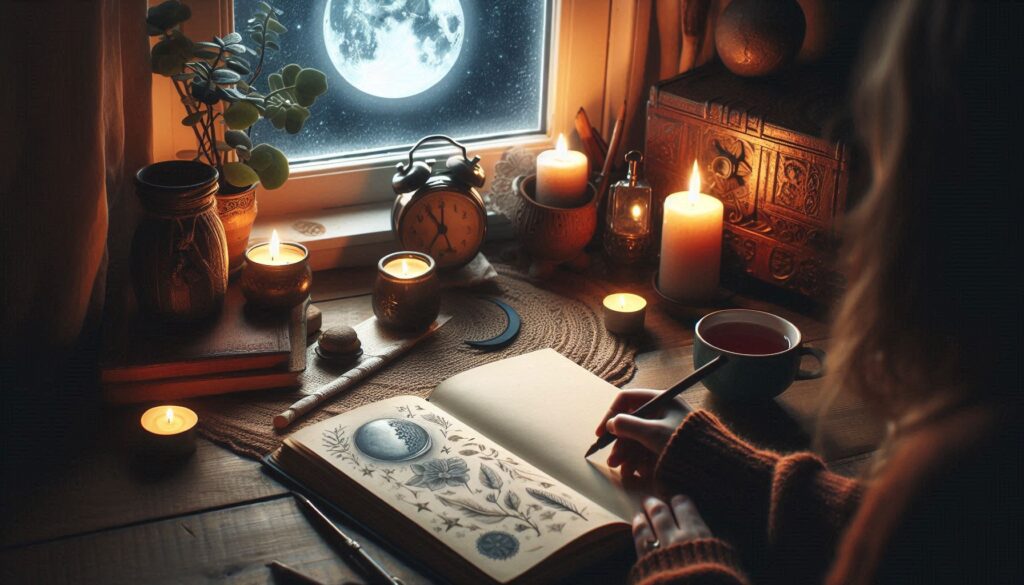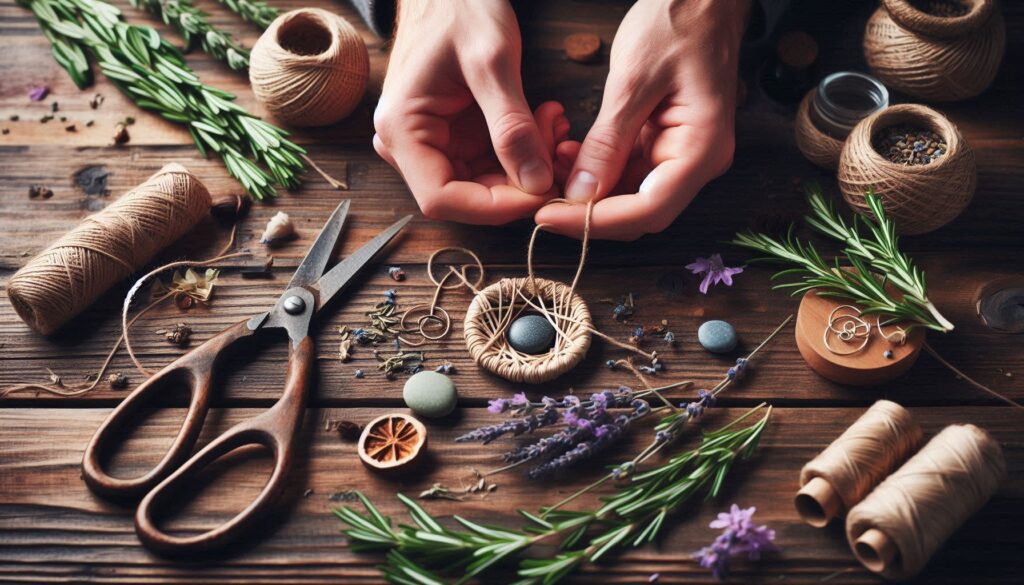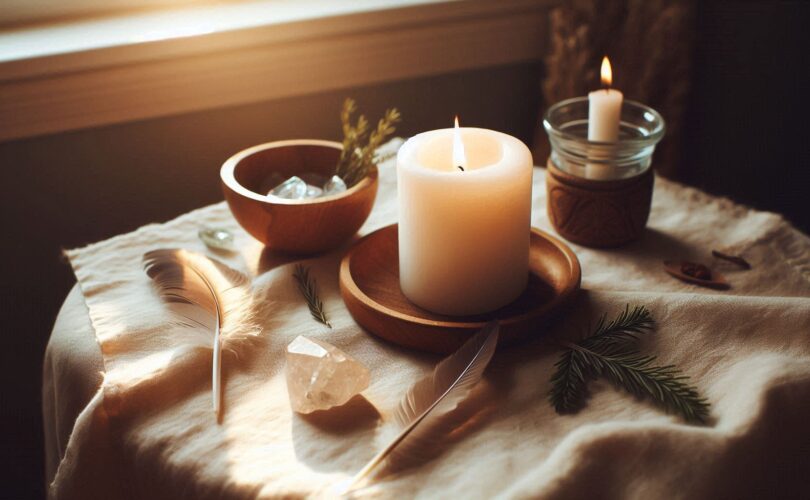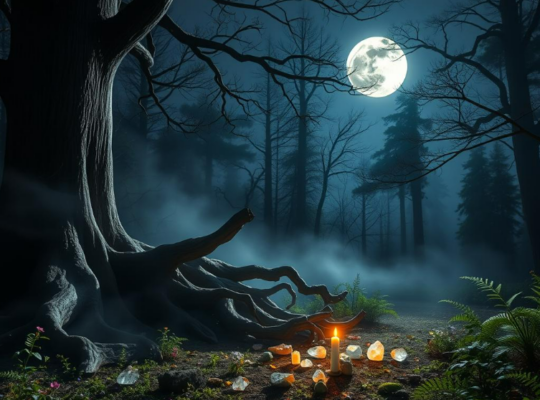Have you felt a special connection to nature, been drawn to the cycles of the moon, or found yourself curious about the healing powers of plants and crystals? Maybe you’ve wondered if you might have a bit of magic inside you. If your heart has been calling you toward a more intentional, nature-connected way of living, you may be feeling the pull to explore witchcraft. This guide will help you take your first steps on this beautiful, transformative path with confidence and clarity.
What Does It Mean to Be a Witch Today?
In our busy, technology-filled world, becoming a witch might seem like stepping into the past. But modern witchcraft is very much alive and thriving, offering a perfect balance to our fast-paced lives.
Being a witch today means joining a diverse community that honors both ancient wisdom and modern understanding. At its heart, witchcraft is about connecting with nature, practicing mindfulness, staying grounded, and committing to personal growth.
A witch is someone who practices witchcraft—an art centered on working with natural energies to create positive change in themselves and the world around them. Modern witches come from all walks of life. They might be nurses, teachers, parents, artists, or students. What connects them is their desire to learn, grow, and build meaningful relationships with themselves, others, and the natural world.
It’s important to understand that witchcraft isn’t just a trend or aesthetic you see on social media. While #witchesofinstagram might show beautiful altars and crystal collections, true witchcraft is a lifelong path of learning and personal transformation that blends spiritual practice with everyday life.
Why choose this path? Because witchcraft offers a unique way to navigate life with intention and purpose. It helps you develop a deeper understanding of yourself and your place in the web of existence, bringing together the practical and spiritual aspects of being human in a way that feels whole and authentic.
Clearing Up Misunderstandings About Witchcraft
Before we dive deeper, let’s address some common misconceptions that might be holding you back:
Witchcraft is not devil worship. Modern witchcraft has nothing to do with evil or the devil. Instead, it focuses on honoring nature, developing personal power, and creating positive change.
Witches don’t look a certain way. Forget the old woman with warts and a cauldron. Today’s witches could be anyone you meet—your neighbor, your doctor, your mail carrier. Some might dress in flowing clothes and jewelry with magical symbols, while others look like everyone else.
Spells aren’t quick fixes. Witchcraft isn’t about snapping your fingers for instant results. Spells are focused intentions supported by ritual actions that work with natural energies over time. Think of them as planting seeds that need nurturing to grow, not pushing a vending machine button.
It’s more than an aesthetic. While altar setups and crystal collections can be beautiful, real witchcraft happens in the heart and mind. The most powerful magic often leaves no visible trace at all.
There’s no single “right way” to practice. Your witchcraft journey will be as unique as you are. While there are traditions with specific practices, most modern witches create a path that resonates with their own beliefs and experiences.
Witchcraft welcomes everyone. People of all genders, backgrounds, and abilities can practice witchcraft. While some traditions honor feminine divine energy, the craft itself is open to anyone drawn to its wisdom.
Ethics matter greatly. Contrary to the “anything goes” idea, most witchcraft paths emphasize responsibility and ethical considerations. Many follow principles like “harm none” or believe that energies you send out return to you multiplied.
By understanding these truths, you’ll approach witchcraft with clearer eyes and an open heart, ready to explore its authentic depth and beauty.
Setting Your Intentions as a New Witch
As you begin your witchcraft journey, take time to reflect on why you’re drawn to this path. Your intentions will serve as your compass, helping you navigate choices and challenges along the way.

Questions to Guide Your Reflection
Find a quiet moment to consider these questions. You might want to write your thoughts in a journal, letting your answers emerge naturally without judgment:
- What sparked my interest in witchcraft? Was it a desire for healing, empowerment, connection to nature, or something else?
- Which aspects of witchcraft resonate with me most strongly?
- Do I feel a connection to nature, the elements, or certain deities or energies?
- What parts of my current life feel out of balance or in need of transformation?
- Am I willing to commit time and energy to developing my practice?
- What do I hope to gain or experience through witchcraft?
- How comfortable am I with exploring both light and shadow within myself?
- Does the idea of working with rituals, symbols, and intentions feel natural to me?
Be honest with yourself. If you’re drawn to witchcraft because of a recent heartbreak and hope to cast love spells, acknowledge that. But recognize that witchcraft offers much deeper healing than quick fixes—it might help you develop self-love and emotional resilience instead.
Creating Your Statement of Intent
Based on your reflections, craft a simple statement of intention for your witchcraft practice. This isn’t carved in stone—it will evolve as you grow. For now, it simply clarifies your purpose and direction.
For example: “My intention in exploring witchcraft is to deepen my connection with nature, develop my intuition, and create more balance and healing in my daily life.”
A Simple Ritual to Seal Your Intention
Once you’ve crafted your intention, honor it with a simple ritual:
- Light a candle in a quiet space
- Take three deep breaths to center yourself
- Say your intention aloud, feeling the meaning of the words
- Visualize your intention as a warm light growing inside you
- Express gratitude for beginning this journey
- Extinguish the candle, knowing your intention has been set in motion
In the days that follow, notice how this intention influences your thoughts and choices. You’ve taken your first magical step!
Discovering Your Unique Witchcraft Path
As you explore witchcraft, you’ll discover there are many different types of witches and paths. Think of these as different flavors or approaches—each with their own focus and practices.
Types of Witches
The Eclectic Witch combines practices from different traditions, creating a personalized approach that resonates with their unique spirit. This path offers freedom and flexibility but requires research and strong ethics.
The Green Witch focuses on plant magic, herbalism, and deep connection with the natural world. If you feel most at home among growing things and want to work with the healing power of plants, this path might call to you.
The Kitchen Witch finds magic in everyday activities like cooking, baking, and caring for the home. They turn ordinary tasks into sacred acts by infusing them with intention.
The Hedge Witch works with herbs, healing, and spirit communication. They often practice “crossing the hedge” between worlds through meditation, dreamwork, or other consciousness-shifting techniques.
Other types include Sea Witches (working with ocean energies), Cosmic Witches (working with celestial forces), and many more. Remember, these labels are just helpful descriptions—many witches combine elements from different types or don’t identify with any specific category.
Spiritual Paths in Witchcraft
While types of witches describe what you do, paths relate more to your overall approach and beliefs:
Wicca is one of the most well-known paths, with structured rituals, celebration of eight seasonal festivals, and worship of a God and Goddess. It follows ethical guidelines like the Wiccan Rede (“harm none”).
Traditional Witchcraft refers to practices based on pre-modern European folk magic and wisdom, often focused on working with the land, ancestors, and local spirits.
Eclectic Witchcraft creates a personal practice drawn from various traditions and beliefs, shaped by individual intuition and needs.
Remember that you don’t need to choose a specific label right away—or ever. Many witches practice for years before finding the path that truly feels like home, and some never choose a single approach. Your practice should feel authentic to you, not forced into someone else’s definition.
Creating Your Witch’s Toolkit
While you don’t need fancy tools to practice witchcraft, certain items can help focus your intention and enhance your practice. Start simply, adding pieces that truly resonate with you rather than trying to collect everything at once.

Essential Tools to Consider
Journal or Book of Shadows: A place to record your magical experiences, spells, dreams, and learning. This becomes a valuable resource as you grow.
Candles: Used in many rituals to represent elements, intentions, or divine energies. White candles can be used for almost any purpose.
Natural Items: Feathers, stones, shells, or plants from places that feel special to you carry personal energy and connection.
Altar Cloth: A special piece of fabric to define your sacred space, chosen in colors that match your intentions.
Bowl of Water: Represents emotion, intuition, and purification in many rituals.
Salt: Used for protection, cleansing, and grounding energy.
Incense or Herbs: Different scents support different magical purposes, from calming lavender to protective rosemary.
Crystal or Stone: Even one special stone can be a powerful focus for energy work. Clear quartz is versatile for beginners.
Tools for Specific Practices
As your practice develops, you might add:
Tarot or Oracle Cards: For insight and guidance about life questions.
Athame (Ritual Knife): Used to direct energy, not for cutting physical objects.
Wand: Helps focus and direct your magical intention.
Cauldron: For burning herbs or paper in releasing rituals.
Herbs and Essential Oils: For specific magical purposes and healing work.
Crystals: Different stones carry unique energies for various intentions.
Ethical Considerations
When building your toolkit:
Source Responsibly: Some items like white sage and palo santo face overharvesting. Research ethical alternatives or grow your own herbs when possible.
DIY When Possible: Making your own tools infuses them with personal energy and intention.
Thrift and Repurpose: Many magical tools can be found second-hand or repurposed from everyday items. A special cup becomes a chalice; a wooden spoon becomes a wand.
Start Small: You don’t need everything at once. Begin with what feels essential and add slowly as your practice develops.
Remember, the most powerful tool in witchcraft is always your intention. A witch with clear focus can work powerful magic with nothing but their mind and heart.
Creating Sacred Space for Your Practice
Your sacred space is where you’ll connect with magical energies, perform rituals, and develop your practice. Whether it’s an elaborate altar or simply a corner of your room, this space becomes a physical representation of your magical journey.
Setting Up Your Altar
An altar is a dedicated space that holds your magical tools and serves as a focal point for your practice:
Location: Choose a spot that feels special and where you won’t be disturbed. This could be a shelf, small table, windowsill, or even a portable box if you need privacy.
Direction: Some traditions suggest facing your altar toward a specific direction (north for earth energy, east for air, etc.), but what matters most is that it feels right to you.
Cleansing: Before setting up, cleanse the space with sound (like ringing a bell), smoke (from herbs like rosemary or cedar), or visualizing white light filling the area.
Center: Place items that represent your core spiritual beliefs in the center—perhaps a special stone, candle, or symbol.
Elements: Many altars include representations of earth (stones, salt), air (feathers, incense), fire (candles), and water (a small bowl).
Personal Touches: Add objects that have meaning to you—photos of loved ones, items from nature, or symbols of your intentions.
Your altar can change with the seasons, moon phases, or your current focus. It grows and evolves with your practice.
Simple Rituals for Your Space
These basic practices help you connect with your sacred space:
Grounding Meditation: Sit before your altar, visualize roots growing from your body into the earth, and feel stable energy rising to support you.
Candle Lighting: Light a candle with intention, stating your purpose for the day’s practice.
Gratitude Offering: Leave a small offering (water, flower petals, or a pinch of food) with thanks for guidance and support.
Space Cleansing: Regularly refresh your space’s energy using sound, smoke, or visualization.
Remember that your sacred space is personal—it should reflect your unique connection to magic and feel welcoming and comfortable to you.
Protection Practices for New Witches
As you open yourself to magical energies, learning protection techniques helps you stay centered and safe. Protection isn’t about fear—it’s about creating healthy boundaries so you can explore confidently.
Why Protection Matters
When you begin working with energy and intention, you become more sensitive to the energies around you. Protection practices help you:
- Keep your personal energy clear and strong
- Create boundaries between yourself and unwanted influences
- Maintain balance during magical work
- Process emotions that arise during spiritual practice
- Return to center when feeling scattered
Simple Protection Methods
Try these accessible techniques:
Visualization Shield: Close your eyes and imagine protective light surrounding you like a bubble or egg. Choose a color that feels protective to you (white, blue, gold, and purple are common choices).
Salt Boundaries: Sprinkle a line of salt across doorways or around your sacred space to create energetic boundaries.
Protective Symbols: Draw or wear symbols that represent protection in traditions that resonate with you, such as the pentacle, eye of Horus, or a simple circle.
Cleansing Bath: Add sea salt and protective herbs like rosemary to bath water, visualizing negative energies washing away.
Grounding Practice: After any magical work, place your hands on the earth (or floor) and visualize excess energy flowing downward, returning to the earth.
Protection Chant: Create a simple phrase that helps you feel protected, such as “I am safe, I am strong, I am protected all day long.” Repeat while visualizing safety surrounding you.
Protection magic becomes more intuitive with practice. Listen to your instincts—if something feels off, take a step back and reinforce your boundaries before continuing.
Understanding Elemental Energy
The elements—Earth, Air, Fire, Water, and Spirit—form the foundation of many magical practices. Learning to work with these energies gives you powerful tools for transformation and balance.
The Five Elements and Their Qualities
Earth represents stability, grounding, abundance, and physical health. Connect with Earth through gardening, working with crystals, walking barefoot outside, or simply sitting against a tree.
Air governs thought, communication, inspiration, and clarity. Engage Air by working with feathers, practicing breathwork, using incense, or sitting in windy places.
Fire embodies transformation, passion, will, and energy. Work with Fire through candles, sitting by a campfire, watching sunrise/sunset, or vigorous movement that warms your body.
Water rules emotion, intuition, healing, and flow. Connect with Water through drinking herbal tea mindfully, taking cleansing baths, visiting natural water sources, or working with moon energy.
Spirit (sometimes called Ether) represents connection, oneness, and the divine spark in all things. Engage with Spirit through meditation, prayer, or practices that help you feel connected to something larger than yourself.
Working With Elemental Energy
Balance Check: Notice which elements feel strongest in you and which might need more attention. If you’re always busy and thinking (Air) but rarely connected to your emotions (Water), you might focus on bringing more Water energy into your life.
Elemental Meditation: Sit quietly and visualize each element in turn, feeling its qualities and inviting balanced expression of that energy in your life.
Seasonal Connections: Different seasons naturally emphasize different elements: Spring (Air), Summer (Fire), Autumn (Earth), Winter (Water). Align your practice with these natural cycles.
Altars: Create a special space with symbols of all five elements to help maintain balance in your practice and life.
Understanding the elements isn’t just for rituals—it helps you recognize imbalances in daily life and take steps to restore harmony through simple, intentional practices.
Beginning Practical Magic
Now that you understand the foundations, let’s explore how to bring magic into your everyday life through simple but powerful practices.
Daily Magical Practices
The most powerful magic often comes from small, consistent actions that align your daily life with your intentions:
Morning Intentions: When you wake up, take a moment to set an intention for the day while lighting a candle or sipping a cup of tea.
Kitchen Magic: Stir love into family meals by adding intentions to ingredients. Cinnamon for warmth and protection, basil for prosperity, rosemary for clarity—all can be added with purpose.
Cleansing Visualizations: While showering, imagine the water washing away negative energy along with physical dirt.
Grateful Moments: Before sleep, name three things you’re grateful for, strengthening your connection to abundance.
Moon Awareness: Notice the phase of the moon and how it might influence your energy and emotions.
Your First Spells
When you’re ready to try structured spellwork, start with these beginner-friendly options:
Candle Intention: Write a simple goal on a piece of paper. Place it under a candle in an appropriate color (green for growth, blue for peace, pink for self-love), and light it while visualizing your intention coming true. Let it burn completely (safely).
Herbal Sachet: Create a small cloth bundle with herbs that match your intention. Carry it with you or place it somewhere relevant (like under your pillow for sleep spells).
Cleansing Spray: Mix water, a bit of alcohol or witch hazel, and a few drops of essential oil (like lemon for freshness or lavender for calm) in a spray bottle. Charge it with your intention to clear negative energy, then use it to refresh your home.
Jar Spells: Place symbols of your intention (herbs, crystals, written words) in a jar, seal it, and keep it somewhere appropriate—like on your desk for a work success spell.
Keeping Track of Your Magic
A crucial part of developing as a witch is recording your practice:
Journal Regularly: Write down what you did, when you did it, how you felt, and any results you notice.
Moon Tracking: Note the moon phase during your workings to see patterns in effectiveness.
Seasonal Awareness: Record how different times of year affect your energy and magical work.
Dreams: Keep track of dreams, especially after magical workings, as they often contain valuable insights.
Through these simple practices, you’ll develop your own understanding of how magic works with and through you, building confidence and skill with each experience.
Growing Your Practice Over Time
Witchcraft is a lifelong journey of learning and transformation. As you continue on this path, your practice will naturally deepen and evolve.
Developing Your Intuition
Your intuition is perhaps your most valuable magical tool. Here’s how to strengthen it:
Daily Check-ins: Take a moment each day to ask yourself how you’re feeling and what you need. Learning to listen to yourself builds intuitive muscles.
Nature Observation: Spend time regularly in natural settings, noticing subtle changes and patterns.
Dream Work: Keep a dream journal by your bed and write down dreams immediately upon waking, looking for patterns and messages.
Body Wisdom: Practice feeling sensations in your body when making decisions. Does an option feel expansive or contracting? Light or heavy?
Advancing Your Studies
As you grow more comfortable with basics, you might explore:
Divination: Tarot cards, pendulums, or scrying tools can help you access deeper wisdom.
Herbalism: Learning about plants and their properties connects you to ancient healing traditions.
Astrology: Understanding cosmic patterns adds depth to timing your magical work.
Mythology: Exploring stories of deities and heroes from cultures that resonate with you can provide powerful archetypes for your practice.
Community Connections
While many witches practice alone, finding community enriches your journey:
Online Groups: Find supportive communities that match your interests and ethics.
Local Shops: Metaphysical stores often host workshops and gatherings.
Nature Groups: Hiking clubs, gardening communities, and environmental organizations often attract nature-connected people.
Study Circles: Form or join a small group to explore specific magical topics together.
The Heart of Witchcraft
As your practice grows, remember that witchcraft is not about collecting tools or performing perfect rituals. It’s about developing a conscious relationship with yourself, nature, and the unseen energies that connect all things. The real magic happens in how you transform and how you bring that transformation into creating a more compassionate, balanced world.
Your Continuing Journey
You’ve taken your first steps on the witch’s path. Remember that this journey has no final destination—it’s a continuous unfolding of growth, discovery, and wonder.
Whether you practice alone or eventually join a community, your path will be uniquely yours. Some days will bring profound insights; others will feel ordinary. Both are valuable parts of the journey.
Be patient with yourself as you learn. Approach each experience with curiosity rather than judgment. Trust that you’ll find your way, guided by your intuition and the wisdom of those who walked this path before you.
Your magical journey has begun. May it bring you healing, wisdom, and joy as you discover the witch that has always lived within you, waiting to emerge.







